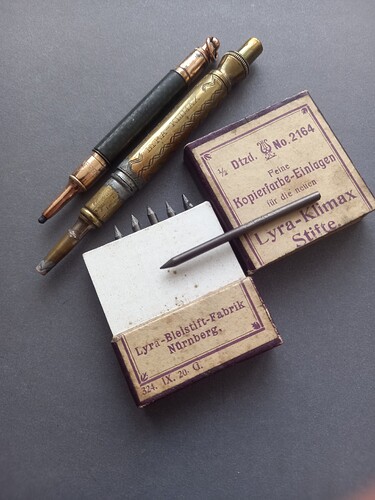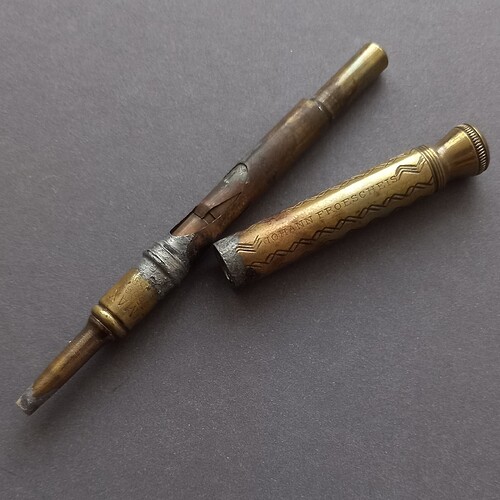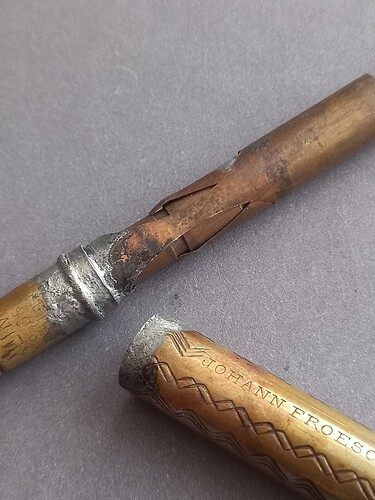Now there’s a name I’ve not heard of in a long while. I think he was (is) heavy into fountain pens.
Indeed, he’s big in the world of FP’s.
But. If you visit his website penboard.de, you can find a few ads here and there dedicated to MP’s — mostly, old bakelite specimens in the broader category of twistaction, propelling and repeater models — and after meeting him in person a few years ago, I periodically visit that website.
During one of my visits, I chose a few items to buy, including this Lyra Klimax: the price felt right, the conditions were next to perfect, there was the box included (a delightful little box with marbled paper on the outside), and it was one of the first detours from Ebay.
The brochure “Meilensteine – 150 Jahre Lyra-Orlow” (“Milestones – 150 of Years Lyra-Orlow”), issued in 1956, contains a few details on the Klimax:
In Nuremberg, the Lyra pencil factory launched a mechanical pencil as early as 1883 in which the lead was held in place by a clamp, which was regulated by pressing a button on the edge of the pencil. The design of today’s artists’ and technical pens can be traced back to the to this invention made by the Lyra pencil factory in 1883.
Very old catalogues show that the Klimax pencil, which is still so popular today, already existed in 1887. What is taken for granted today was a sensation at the time. Due to its epoch-making construction of a combination of a push and twist mechanisnm the Klimax was the first and only pocket pencil that could be used one hand.
The first one-handed mechanical pencil came from the Lyra pencil works in Nuremberg. It was produced in quantities that were almost unimaginable at the time and sold at home and abroad after the patent for it had already been acquired. Branded articles in today’s sense did not yet exist at that time, but the Klimax had its name, its stamp and it also left a special mark on its time. At that time, it was not only produced for Germany, but also for Austria-Hungary and many other countries.
Production could hardly keep up, the Klimax went all over the world. Particular importance was attached to the exterior of this lyre parade pen. Since artificial horn, celluloid etc. were not yet known, the cases and sleeves of the pens were made from finely polished wood, enamel, agate, hard rubber and ivory. A large proportion of the Klimax pens were made of genuine silver, doublé or 14-carat gold.
Never thought about that, but now that I read it, it is indeed obvious.
Thank you @Gunther for this piece of history: it really puts a shine on the humble shade of grey my Klimax sports, like a badge of honour. ![]()
Yes, thank you from me also - somehow I had never really noticed how innovative Lyra was in the world of pencils.
The Klimax may well have been produced in “quantities that were almost unimaginable”, but I still haven’t got one!
Here’s a couple of older Klimax models I picked up. The busted one I bought specifically to disassemble to see how it worked, as I love how innovative and excellent the operation is. The inner copper leaves cut from two outer layers of the inner barrels allow you to see some of how precisely the more ‘sticky’ copper is use to pull and push the tip out. It’s really quite ingenious how the ratchet trombone action catches the barrel with one push then releases it with a second, whilst twisting the button at the tail extends the lead in a traditional twist advance motion. I’ve seen adverts from the 1880s for these.


